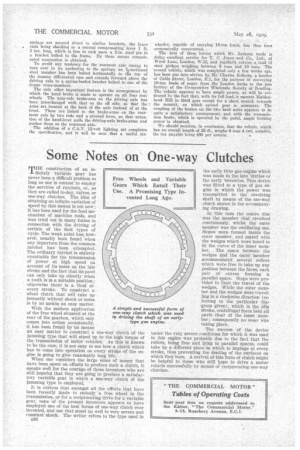Some Notes on One-way Clutches
Page 62

If you've noticed an error in this article please click here to report it so we can fix it.
THE construction of an infinitely variable gear has never been a difficult problem so long as one is content to employ the services of ratchets, or, as they are called to-day, valves, or one-way clutches. The idea of obtaining an infinite variation of speed by this means is not new ; it has been used for the feed mechanisin of machine tools, and was tried out in many forms in connection with the driving of certain of the first types of cycle. The weak point has, however, usually been found when any departure from the common ratchet has been attempted. The ordinary ratchet is entirely unsuitable for the transmission of power at high speed on account of its noise on the idle stroke and the fact that its pawl can only take up silently when a tooth is in a suitable position ; otherwise there is a thud at every stroke. To construct a silent clutch that will take up instantly without shock or noise is by no means an easy matter.
With the modern application of the free wheel situated at the rear of the gearbox, which only comes into action occasionally, it has been found by no means an easy matter to construct a one-way clutch of the jamming type that will stand up to the high torque of the transmission of motor vehicles. As this is known to be the case, it is not easy to see how a clutch which has to come into operation on every stroke of the engine is going to give reasonably long life.
When one considers the large sums of money that have been ,spent on efforts to produce such a clutch, it speaks well for the courage of those inventors who are still hopeful that they are going to produce a satisfactory variable gear in which a one-way clutch of the jamming type is employed.
It is curious that amongst all the efforts that have been recently made to embody a free wheel in the transmission, er for a reciprocating drive for a variable gear, none of the present inventors, appears to have employed one of the best forms of one-way clutch ever invented, and one that stood up well to very severe and constant shock. The writer refers to the type used in
the early OLto gas engine which was made in, the late 'sixties or the early 'seventies. This device Was fitted to a type of gas engine in which the power was transmitted to -the revolving shaft by means of the one-way clutch shown in the accompanying drawing.
In this case the centre disc was the member that revolved .continuously, whilst the outer member was the oscillating one. Slopes were formed inside the outer member, and mated with the wedges which were bored to fit the curve• of the inner member. The space between the wedges and the outer member accommodated several rollers which were free to take up any position between the faces, each pair of curves forming 'a parallel space. Stops were provided to limit the travel of the wedges. While the outer member and the wedges were travelling in a clockwise direction (referring to the particular diagram given), which is the idle gtroke, centrifugal force held all parts clear of the inner member; consequently no wear was taking place.
The success 'of the device under the very severe conditions for which it was used in this engine was probably due to the fact that the rollers, being free and lying in parallel spaces, could take up a different place in which to impinge at every stroke, thus preventing the denting of the surfaces on which they bore. A revival of this form of clutch might be helpful to those who still hope to drive a motor vehicle successfully by mean of reciprocating one-way clutches.




















































































































